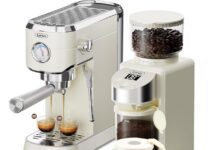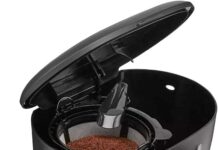When it comes to brewing our morning pick-me-up, the size of our coffee maker is a crucial factor in ensuring we get just the right amount to kickstart our day. But how many cups does a 9-cup Bialetti actually make? This burning question often leaves coffee enthusiasts scratching their heads, and today, we’re here to spill the beans and provide you with the answer you’ve been craving. Stick around as we dive into the world of Bialetti coffee makers and discover the secret behind this mysterious cup designation. Get ready to brew up some knowledge!
What is a 9-cup Bialetti?
When it comes to making coffee at home, there are countless options available, but one brand that stands out is Bialetti. Bialetti coffee makers have been a staple in Italian households for decades, known for their simplicity and ability to produce rich, flavorful espresso. One popular size in the Bialetti range is the 9-cup model, which many coffee lovers find perfect for their brewing needs. In this article, we will delve into the details of what exactly a 9-cup Bialetti is and how it can meet your coffee cravings.
Overview of Bialetti coffee makers
Before we dive into the specifics of the 9-cup Bialetti, it’s worth taking a moment to understand the brand and its coffee makers as a whole. Bialetti is an Italian company that has been specializing in coffee-related products since its inception in 1919. Their coffee makers are renowned for their iconic design, with the Moka Express being a particularly famous model.
Bialetti coffee makers operate on a stovetop, using a steam pressure system to extract the coffee’s flavors. This method results in a rich, full-bodied brew that is often referred to as espresso. The capacity of these coffee makers is typically denoted by the number of “cups” they can produce, but it’s important to note that these cups are not the same as the standard measuring cups we are accustomed to.
Understanding the cup measurements
When it comes to coffee makers, the term “cup” can be a bit misleading. In the case of Bialetti coffee makers, a “cup” refers to a small serving of coffee, roughly equivalent to 1.5 ounces or 44 milliliters. This differs from the standard measuring cup used in recipes, which holds 8 fluid ounces or about 240 milliliters.
Cup Measurement Differences
To avoid confusion, it’s crucial to understand the differences in cup measurements between Bialetti coffee makers and the standard measuring cups used in recipes.
Italian espresso cup size
In Italy, a traditional espresso cup has a small capacity, usually around 60 milliliters or 2 ounces. These cups are designed to hold a single shot of espresso, which is significantly smaller than what we typically consider a cup of coffee.
Standard US measuring cup size
In the United States, a standard measuring cup is equivalent to 8 fluid ounces. This measurement is based on the American customary system and is commonly used for cooking and baking recipes. It’s important to keep in mind that Bialetti’s cup measurements are considerably smaller than this standard.
Defining ‘Cups’ in Bialetti Terms
Now that we have a clear understanding of the differences in cup measurements, let’s explore how Bialetti defines cups in their coffee makers.
How Bialetti measures cups
When Bialetti refers to the size of their coffee makers in “cups,” they are using their own standard of measurement. As mentioned earlier, their cups are small servings of coffee, measuring around 1.5 ounces or 44 milliliters. Therefore, a 9-cup Bialetti has a total capacity of approximately 13.5 ounces or 396 milliliters.
Bialetti’s recommended serving size
For optimal taste and quality, Bialetti recommends using their coffee makers to brew espresso-sized servings. This means that the 9-cup Bialetti is designed to produce nine small espresso shots, rather than nine standard cups of coffee. Understanding this distinction is crucial when trying to determine the yield of a 9-cup Bialetti and how it aligns with your personal coffee preferences.
Understanding the ‘9-cup’ Capacity
Now that we know the specifics of Bialetti’s cup measurements, let’s delve into the details of the 9-cup Bialetti and what its capacity truly means.
Bialetti’s definition of a ‘cup’
As we established earlier, Bialetti’s cups are much smaller than the standard measuring cups used in recipes. Therefore, a 9-cup Bialetti does not refer to producing 9 standard cups of coffee but rather 9 small espresso shots.
Calculating the total volume
To determine the total volume of a 9-cup Bialetti, we multiply the capacity of a single cup (1.5 ounces or 44 milliliters) by the number of cups (9). This calculation yields a total volume of approximately 13.5 ounces or 396 milliliters.
How many actual cups it brews
Given that the 9-cup Bialetti is designed to produce nine small espresso shots, it may be helpful to estimate how many actual cups of coffee this would translate to. If we consider a standard cup of coffee to be 8 fluid ounces, then the 9-cup Bialetti would likely yield around 1.68 cups of coffee. However, it’s important to note that this is a rough estimate, as the strength and intensity of the espresso shots may vary based on personal preference and brewing factors.
Factors Affecting Cup Yield
Several factors can influence the actual cup yield when using a 9-cup Bialetti. Let’s explore these factors in detail.
Coffee grounds-to-water ratio
The ratio of coffee grounds to water plays a significant role in determining the strength and yield of the brewed coffee. Adjusting the amount of coffee grounds used in the Bialetti can impact the intensity of the espresso shots and ultimately affect the number of cups produced.
Size of the espresso cup
The size of the espresso cups used to collect the brewed coffee also affects the overall cup yield. If smaller espresso cups are used, it will result in more cups, albeit with smaller servings. Conversely, larger espresso cups would yield fewer cups but with larger servings.
Brewing time and heat
The brewing time and heat applied during the coffee-making process can influence the extraction of flavors and the strength of the resulting brew. Adapting brewing time and heat can lead to variations in cup yield and the overall taste profile of the coffee.
Typical Yield of a 9-Cup Bialetti
While the individual preferences and brewing parameters may vary, let’s explore the typical yield one can expect from a 9-cup Bialetti.
Average serving size
As mentioned earlier, Bialetti’s recommended serving size is based on espresso-sized shots. Therefore, using a 9-cup Bialetti would typically result in nine small servings of coffee.
Equivalent volume in fluid ounces
To provide a reference point, the approximate equivalent volume of a 9-cup Bialetti is around 13.5 fluid ounces or 396 milliliters. This corresponds to the total capacity of the coffee maker, allowing for slight variations due to brewing factors.
Approximate number of cups
While the true number of cups will depend on personal coffee preferences and factors such as cup size, a 9-cup Bialetti can roughly yield 1.68 cups of standard-sized coffee. However, it’s essential to remember that the primary purpose of a Bialetti coffee maker is to produce rich, concentrated espresso shots, rather than large quantities of coffee.
Adjusting the Yield
If the typical yield of a 9-cup Bialetti does not align with your desired serving size, there are several adjustments you can make to customize the output.
Using smaller espresso cups
By using smaller espresso cups to collect the brewed coffee, you can increase the number of servings produced by a 9-cup Bialetti. This allows for more cups with smaller volumes, catering to those who prefer multiple smaller servings rather than a few larger ones.
Increasing or decreasing coffee grounds
Adjusting the amount of coffee grounds used can directly impact the strength of the espresso shots and subsequently influence the overall cup yield. Increasing the amount of coffee grounds may result in a stronger brew but could also reduce the number of cups produced. Conversely, decreasing the amount of coffee grounds may yield milder shots and potentially increase the number of cups.
Adapting brewing time
Another way to modify the cup yield is by adjusting the brewing time. Increasing or decreasing the brewing time can affect the extraction process, altering the concentration of flavor and the strength of the coffee. Experimenting with different brewing times may allow you to find the perfect balance between cup yield and taste preference.
Additional Considerations
In addition to the factors mentioned above, there are a few other considerations when brewing coffee with a 9-cup Bialetti.
Crema volume
Crema is the foamy layer that forms on top of a well-brewed espresso shot. It adds depth and complexity to the coffee’s flavor profile. The volume of crema can affect the perceived yield of the coffee, as it takes up space in the espresso cup. It’s worth keeping this in mind when assessing the total cup yield.
Understanding the strength of the coffee
Bialetti coffee makers are known for producing strong, concentrated coffee. Understanding this strength and intensity is essential when evaluating the yield and determining how it aligns with your personal preferences. Remember that Bialetti’s focus is on quality and boldness of taste, rather than quantity.
Accounting for evaporation
During the brewing process, some evaporation may occur, leading to a slight decrease in the overall cup yield. While this evaporation is minimal, it’s important to consider when estimating the final number of cups produced.
Care and Maintenance
To ensure that your 9-cup Bialetti continues to brew delicious coffee, it’s vital to take proper care of it. Here are some tips for cleaning, replacing parts, and storing the coffee maker.
Cleaning a 9-cup Bialetti
Cleaning a Bialetti coffee maker is relatively straightforward. After each use, disassemble the coffee maker, wash the parts with warm water and mild soap, and thoroughly dry them before reassembling. Avoid using harsh cleaning agents, as these can damage the aluminum and affect the coffee’s taste.
Replacing parts and gaskets
Over time, the gaskets and other parts of your 9-cup Bialetti may wear out or become damaged. It’s essential to replace these components to maintain the coffee maker’s functionality and prevent any leaks. Replacement parts and gaskets can usually be purchased directly from Bialetti or through authorized retailers.
Storing the coffee maker
When not in use, store your 9-cup Bialetti in a dry and clean area. Ensure that all parts are completely dry before reassembling and storing to prevent any moisture buildup or potential corrosion. Proper storage will help prolong the lifespan and optimize the performance of your coffee maker.
Conclusion
A 9-cup Bialetti is a versatile and reliable coffee maker that can provide you with rich, flavorful espresso shots. By understanding the cup measurements, factors affecting the cup yield, and how to adjust it to your preferences, you can make the most out of your brewing experience. Remember to take proper care of your coffee maker through regular cleaning, part replacement, and appropriate storage. With a 9-cup Bialetti, you can enjoy the essence of Italian coffee culture in the comfort of your own home. Cheers to delicious coffee!





































